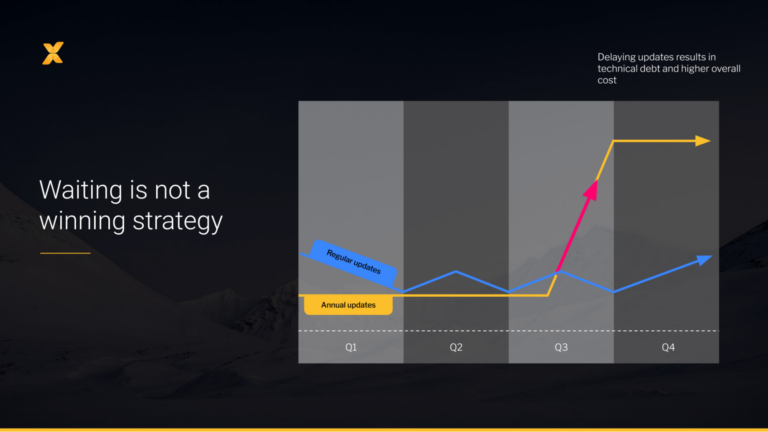Until not long ago, it was difficult to imagine that any technology could provide the same user experience as a native mobile app. But over the past few years, as mobile accessibility and fast-loading web experiences have grown increasingly essential for ecommerce, an exciting solution has become available: PWA ecommerce.
TABLE OF CONTENTS
Progressive Web Applications (PWA) are web-based solutions that blend in the best of both worlds; the native mobile app and traditional website to offer a consistent, superior user experience across all connected devices and internet speeds.
Since a PWA is a web application, they don’t require separate distribution or bundling. A PWA runs in the browser while giving users a fast loading and native app-like experience through features like:
- Offline mode app access
- Access through mobile browser home screen.
- Push notifications
Owing to the benefits of higher conversion rates, much-improved customer engagement, shortened page load time, and much lower costs on development and overheads, many consider Progressive Web Apps (PWA) the greatest invention since responsive web design to deliver a fast and smooth user experience.
In this article, we’ll have a closer look at who can benefit from a PWA is for and how to get started.
Related reading: What is PWA – Definition, Benefits, and How to Get Started
Who is PWA For?
Any company selling products or services online would benefit from a PWA. The customer experience is significantly improved with PWAs, and there are no industries where that’s not an advantage.
Today, PWAs are used by many large enterprises like Twitter, AliExpress, Alibaba, and Walmart to increase conversion and revenue. But you don’t have to be a big enterprise to benefit from PWA technology. On the contrary, small and medium-sized ecommerce businesses have much to gain from leveraging PWAs to create smooth and fast customer experiences.
And yet, a survey of ecommerce decision-makers showed that while a significant group of respondents had already introduced PWAs, or were likely to do so shortly, more than half of the respondents didn’t know what PWAs are or were still evaluating. This indicates that the lack of investment in PWA ecommerce stems from insufficient knowledge about progressive web applications and how they can help ecommerce businesses.
Consider, for example, the improved load times that come with PWA. When a mobile page’s load time goes from 1 second to 5 seconds, the bounce probability increases by 90%. And every time a customer gets held up by a slow checkout, a sale is at risk. A PWA’s enhanced user experience and fast load times allow customers to complete their tasks quickly and efficiently. PWAs deliver two to four times faster page speeds, ensuring hard-earned users stay engaged and convert.
Benefits of PWA in Ecommerce
The mobile share of ecommerce is snowballing, and by 2025, mobile web commerce is predicted to generate 44.2% of total retail ecommerce sales. Considering this, it’s no wonder businesses are looking for ways to expand their mobile ecommerce. And while this previously may have required a native app, today, many companies can get the same functionality with a PWA. Combining new and powerful features and performance enhancements allows PWAs to improve the mobile web experience significantly.
Let’s look at a couple of the benefits of PWA ecommerce, both from the user and merchant perspectives.
A Better User Experience and Increased Conversion Rates
PWA provides a better user experience with reduced load times and accessibility. Google has found that 53% of mobile users will abandon a site when it takes longer than a mere three seconds to load. This means loading speed is critical, and PWAs help ecommerce sites provide that. A better user experience also means increased conversions. One example is Alibaba which saw a 76% increase in conversions after introducing PWAs.
Increased Time Spent on Your Site and Improved SEO
The more responsive the user experience is, the longer visitors tend to stick around. And the longer they stick around; the more valuable and relevant Google will deem your content. This creates a positive spiral where your content is ranked higher, attracts more traffic, gets users to stay on your site longer, which in turn helps your site rank even higher, and so on.
Page load speed and user experience are factors that Google is increasingly taking into account when ranking content, so focusing on those parameters will boost your rankings and organic traffic.
You Don’t Have to Start Over: Modular Implementation Makes it Easy to Get Started with PWA
If you want to build a Progressive Web App, you may be wondering where to start, if it’s possible to upgrade a website to a PWA without starting from scratch, or how to move from a platform-specific app to a PWA.
A big misconception is that if you want to benefit from PWA capabilities, you need to completely replace your front end, making businesses believe adopting PWA is a highly intensive and expensive process. But in fact, the opposite is true.
PWA technology allows for modular implementation, allowing businesses to profit from the advantages with a minimum time to market. Progressive Web Apps are still websites, with enhanced features and capabilities. They are not attached to a particular technology stack and you can start from scratch with a new site or update your existing website without a complete overhaul.
Since PWA are just web applications with a manifest file and ServiceWorker, it is definitely possible to enhance an existing application with PWA features. However, sometimes the problem with retrofitting older applications is that they are often not designed to be responsive and their communication is not designed to handle intermittent connections. With that said, you can work on enhancing your existing app step by step. It may not become a “true PWA” overnight, but every step you take will enhance the experience for your users.
For example, if you would like to start by allowing your audience to install your PWA on their home screen, the only thing you need to do is install a Web App Manifest. Furthermore, starting with native-app like Push Notifications can be done within just a few minutes with available extensions.
Applying such techniques in existing stores is the first step to improving user experience and increasing conversion rates within a minimum time to market and at a low cost of implementation.
3 Steps to Get Started with PWA Ecommerce
It’s not that complicated to get started building a PWA and here are some strategies to get you started:
1. Start by Making it Installable
This approach starts with a basic manifest file, a simple offline page, and a service worker to serve the offline page and cache some critical CSS and JavaScript. Thanks to the critical CSS and JavaScript caching, you will get your existing web app ready to work offline while improving its performance.
2. Pick One New Feature
This could be push notifications or file handling, but the key is to pick a feature that will significantly impact your users or your business. This approach will also allow you to ease into PWA without making too many changes at once.
3. Work Backwards
Conduct a low-stakes experiment by rethinking an experience for your users with PWAs in mind from the beginning. For example, take an existing section of your application or a specific user journey and make it work as an offline-first PWA, either stand-alone or in context.
But if you are going through a redesign of your website you have an opportunity to build it from the ground up. This approach enables you to more easily build in PWA design patterns than other strategies, in particular allowing you to take advantage of all the power of service workers from the get-go.
Ready-to-Use PWA Solutions
Today PWAa are more affordable than ever and available to any business willing to adopt the technology. The fastest and most cost-efficient way to implement PWAs is by leveraging a ready-to-use PWA ecommerce solution. Let’s look at some of the most popular ones offered on the market today.
Vue Storefront
Vue Storefront is a fast-growing platform-agnostic PWA that works with almost any ecommerce platform you may want to use. Watching the developer community’s interest in Vue indicates its popularity. Vue Storefront has seen a rapid increase in rating on Github, and the Vue Storefront Slack channel has over 1,200 members.
Deity
Deity is a well-known PWA and micro-services-oriented platform that takes a modular approach to address enterprise PWA requirements. Deity can be used with a wide range of frontends. With the headless configuration, Deity allows businesses to create outstanding web experiences with all the advantages of native apps, but much faster and at a lower cost of ownership.
Gatsby
Gatsby is a popular PWA framework used for building static sites with React. With Gatsby, there’s excellent documentation, and the community of PWA developers is strong. Gatsby is loved by dev teams for enabling the building of lightning-fast websites and web applications.
React
React can be used to build PWAs, and makes it easy to create interactive UIs. React enables developers to build responsive and engaging web experiences on desktop and mobile, helping businesses promote app downloads and develop customer loyalty.
Related reading: Is Composable Architecture Right For You?
Key Takeaways
The amount of traffic and commercial transactions on mobile devices has been increasing yearly. It seems safe to say that we got past the tipping point a couple of years ago, with 2018 desktop-mobile traffic distribution showing that 52% of overall web traffic came from mobile devices during that period. The trend continues to demonstrate steady growth in both usage volume and rate of technological progress, changing the way people interact with the web.
Whether you choose to go full PWA, or take small steps by starting with, for example, Push Notifications and “add to home screen” first, adopting a PWA ecommerce strategy should be a top priority for any type of business, big or small. With minimum required investments and a record speed time-to-market, anyone can start to drastically change the experience they deliver to their audience today, increasing conversion rates — and ultimately improving their bottom-line results.
How Vaimo Can Help
If you need expert advice on PWA ecommerce, don’t hesitate to contact our experts today. With more than 14 years of experience in digital commerce solutions, we deeply understand all things ecommerce. We’ve helped numerous clients scale their digital businesses and meet customers with the best possible digital experiences. Let’s discuss how we can take your digital commerce business to the next level!







